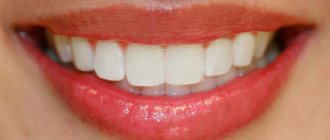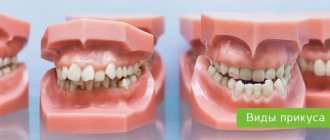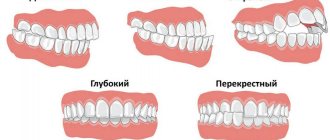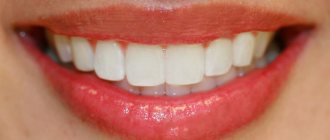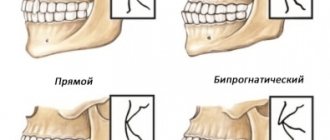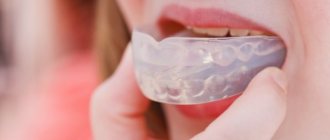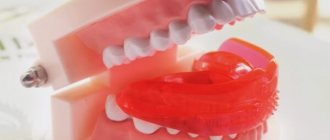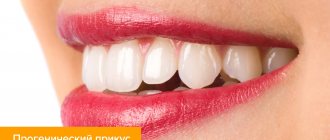53221
Crooked, unhealthy teeth can ruin the appearance of an otherwise attractive person. Oral health is important not only for our attractiveness, because the main function of teeth is to grind food. The condition of the stomach and intestines depends on this, which directly affects health and life expectancy .
How is the bite formed?
The process of bite formation is long - from birth to adolescence. There are 5 periods.
- Initial (up to 6 months): no teeth, the upper jaw is larger in size than the lower jaw. At this time, an active feeding process is extremely important for the proper development of the jaw apparatus.
- Emerging temporary bite (6 months - 3 years): baby teeth and a bite appear, but it is still temporary. This stage is accompanied by inflammation of the gums, a rise in temperature, often grinding of teeth (bruxism), and emerging teeth may be crooked. It is important to maintain hygiene without taking any orthodontic measures.
- Formed temporary occlusion (3 - 6 years): baby teeth have erupted and can close in different ways, jaw growth continues. This is the time of active use of teeth. Characteristic wear of temporary teeth is considered normal before the upcoming change.
- Changeable dentition (6-12 years): jaw growth, loss of baby teeth and appearance of permanent teeth. Often new teeth, especially the lower ones, erupt unevenly. During this period, it is necessary to decide on a plan for further correction of the bite.
- Permanent dentition (12 - 15 years): replacement of milk teeth with permanent ones, all 28 teeth are visible, no wisdom teeth. The period is most favorable for orthodontic treatment.
In order for the bite to form correctly, there must be careful attention to teething, oral hygiene, and a timely plan to correct emerging problems.
Correct closure of teeth: formation stage
The formation of the bite occurs from the first days after birth and lasts until adolescence, on average up to 16 years. The stage begins with the appearance of the first incisors. After replacing all primary dental elements with permanent ones, the bite is determined. Its development is influenced not only by external factors, but also by the form of heredity.
Bad habits that contribute to malocclusion
To avoid malocclusion, the following rules must be followed as a precaution:
- Teeth bite is correct and incorrect - what it should be and how to eliminate anomalies
- Breastfeeding from birth is considered beneficial.
- Try not to give your child rubber nipples or objects of a similar nature.
- If this occurs, wean your child from sucking fingers or toys.
- The child's sleep should be calm, his breathing should be even through the nasal cavity, his mouth should be closed.
- Visit doctors specializing in the oral cavity in a timely manner; it is the dentist who is able to identify pathology in time, eliminate defects, prescribe the correct treatment, or give preventive advice.
It is important to know! Primary incisors must be replaced by permanent ones, strictly in this sequence. If the permanent incisors occupy niches along with the deciduous ones, this is considered unacceptable.
Correcting malocclusion
There is a danger of teeth transitioning from a normal state to malocclusion, which occurs against the background of maxillofacial injuries, due to gum disease, unprofessional prosthetic work, as well as due to the loss of teeth and their prolonged absence.
Video: What determines the formation of a correct bite
Correct teeth bite
An ideal orthognathic bite implies the presence of the following features:
- The upper dental arch is slightly inclined forward and has the shape of a semi-ellipse, the lower, in the shape of a parabola, is slightly backward.
- When the jaws close, each upper tooth contacts the opposite tooth below.
- There are no obvious gaps between the teeth.
- The upper teeth overlap the lower teeth by about a third of their height.
Despite the fact that there are the above parameters for a perfect smile, the question “What should be the bite of the teeth?” cannot be answered unambiguously. In addition to the orthognathic bite, modern orthodontics allows for several options for the normal structure of the dentition and the location of the jaws.
Orthognathic
The upper row of teeth overlaps the lower one by 30% of the height, there are no gaps between the teeth or spaces between the rows.
Biprognathic
The dentition is slightly directed towards the vestibule of the mouth.
Progenic
The lower jaw moves forward slightly.
Straight
When the jaws close, the upper teeth come into contact with the lower cutting edges.
How to determine the correct bite?
Teeth occlusion and alignment are two related terms in dentistry. In addition, there is such a thing as central occlusion. It implies the final arrangement of the dental elements, observed with complete jaw fit. Identification of the correct bite occurs with central occlusion. It is worth noting that it is possible to distinguish not only the closure options, but also the location of the teeth.
Correct bite. Front view
One of the most exemplary types of closure is the option where the upper row of teeth overlaps the lower row by no more than one third. In this case, closure is characterized by complete tight contact.
Do not forget that correct closure is not only the correct jaw position, but also the relatively correct shape and dimensional indicators of the fundamental elements. Therefore, the teeth of the upper jaw should be inclined slightly towards the lips, while the lower jaw is characterized by an inclination towards the tongue.
It is important! With correct occlusion, there are no problems such as facial disharmony, which is very often noted with the mesial type of closure.
Types of malocclusion
Thus, the upper incisors must be adjacent to the lower ones, then the bite can be considered harmonious. Additionally, the following signs of proper teeth closure can be identified:
- Tight contact of teeth without any gaps.
- There are no gaps and no supercontact of the dentition occurs.
- The incisors of the jaws have an exclusively central location.
Natural dental alignment and correct closure eliminate problems with diction, aesthetic problems, disturbances in chewing function, and even breathing.
Malocclusion of teeth
Look at your reflection in the mirror. If you notice an excessively protruding upper or lower lip, teeth that “overlap” each other, or gaps between the dentition when the jaws are closed, this is a clear reason to consult a specialist. Descriptions of dental anomalies and photographs of teeth with malocclusion pathologies are presented in the table below.
Distal (prognathic)
In a distal bite, the upper jaw is more developed than the lower jaw.
Mesial (medial)
With a mesial bite, the lower jaw is pushed forward.
Cross
In a crossbite, the rows of teeth intersect in the manner of scissors when the jaws close.
Deep
In a deep bite, the upper teeth significantly overlap the lower teeth.
Open
The presence of pronounced gaps between the dentition when the jaws are closed indicates an open bite.
Bite in the absence of teeth
A person without teeth has problems with the functioning of the temporomandibular joints, facial aesthetics deteriorate, and wrinkles appear due to loss of skin tone. To avoid unpleasant consequences, it is necessary to restore the bite using a complete denture made using a special technique.
Bite restoration with complete dentures
- The central ratio of the jaws is determined - the position of the lower jaw in relation to the upper in three planes: vertical, sagittal and transversal. The role of the dentition is played by wax rollers.
- Measurements are taken using a device consisting of an external facebow-ruler and an intraoral plate with a flat frontal part and curved distal parts.
- The plaster model marks the boundaries of the future structure, the line of the middle of the alveolar process, the tubercles of the upper and lower jaw, and the midline.
- Artificial teeth are placed in such a way that when you smile, the part of the prosthesis that imitates the gum is not visible.
Indirect dental restoration
The orthopedic or indirect method involves the installation of replacement structures - veneers, lumineers, inlays, crowns. Essentially, this is microprosthetics.
Crowns are installed if most of the tooth has lost its integrity, and the task is not only to improve its aesthetics, but also to provide reliable protection from further destruction. Crowns are placed on both chewing and front teeth.
Aesthetic dental restoration involves the use of veneers and lumineers.
A veneer is a thin plate with a thickness of 0.2 mm, made of ceramics, glass ceramics, zirconium or other materials.
These structures are made from a patient’s impression in the laboratory and then glued to the front of the tooth. Before installing the veneer, the top layer of enamel is ground down.
Advantages of veneers:
- High aesthetic characteristics.
- The color of the materials is resistant to dyes and changes little over time.
- Durability (subject to manufacturing technology and proper patient preparation).
Disadvantages of veneers:
- High price.
- The likelihood of increased tooth sensitivity due to filing of enamel.
- The enamel is cut down irreversibly. If the veneer falls off or there is a need to remove it, additional tooth restoration will be needed.
- Several visits to the dentist are required to install the veneer.
Lumineers are ultra-thin transparent veneers, the manufacturing technology of which is patented by the American company Cerinate.
No grinding of the enamel is required to apply them. Lumineers can be removed and replaced without damaging healthy tooth structure. However, their price is even higher than that of conventional veneers. If there is a significant change in the color of the enamel, the transparent lumineer will not be able to perform a masking function.
Bite after wisdom tooth removal
Some doctors are convinced that wisdom teeth are an atavism and must be gotten rid of. In ancient times, they were used to chew tough foods, such as raw meat. With the development of civilization, the human diet changed, his jaw began to gradually decrease - and the “eights” turned out to be superfluous. Most often, before starting to correct the bite, wisdom teeth are removed. This frees up space for the correct formation of rows, and the result of teeth alignment will be much better.
Direct dental restoration
Tooth restoration is carried out directly in the patient’s oral cavity. The procedure is performed using composite materials that harden under the influence of light.
Dental restoration with composite material
Light-curing composites are also called photopolymers.
Composite dental restoration is both therapeutic in nature - carious cavities are filled with photopolymer, and aesthetic.
The polymer is tinted with special paints, which makes it possible to bring the filling as close as possible to the natural color of the enamel. Therefore, even if your tooth consists of 70% filling, no one will notice it.
The composite is used not only to restore the smile area, but also in the treatment of chewing teeth. Firstly, everything about a person should be perfect - both the front part of the jaw and the side part. And secondly, the photopolymer is close to enamel not only in appearance, but also in strength and hardness. This means that this material is also irreplaceable in high-load areas.
Dental restoration with composite material is performed in several stages:
- Cleaning the tooth from bacteria and necrotic tissue. In our clinic, this is a painless procedure, as it is performed with water-air cooling. And when treating deep caries, all manipulations are performed under local anesthesia.
- Treatment of the cavity with adhesive glue. It ensures reliable adhesion of the filling to the tooth. Almost the same as when connecting healthy tissues.
- Application of light-curing material. It is performed in stages, in layers, since healthy dental tissue is multi-layered. Each layer hardens under the light of a halogen lamp in 2-3 minutes. The dentist needs to select the color of the layer in such a way that the final result looks as natural as possible. This requires from the doctor not only medical professionalism, but also artistic flair.
- Removal of excess material, grinding and polishing.
Photopolymers are chemically neutral and safe for health.
Working with one tooth can take from 15-20 minutes to 2 hours - it depends on the complexity of the case.
Direct dental restoration has its advantages:
- The procedure is performed in one visit.
- High level of aesthetics.
- Several teeth can be restored at one time.
- Gentle treatment of dental tissue.
- The method allows you to restore even severely damaged teeth.
- The optimum ratio of price and quality.
However, the method also has disadvantages. The tooth may change its color over time, then the boundary between the filling material and living tissue will become visible.
Additional care is required to maintain the original appearance of the oral composite material. Restored teeth need to be cleaned with special products, both at home and in the dental office.
What affects the bite of teeth?
The negative impact of defects in the dental system on the condition of the entire organism has been repeatedly proven by scientists. The list of identified health risks is impressive even for ardent optimists.
- Due to improper distribution of the chewing load, tooth enamel wears off faster, teeth begin to react painfully to cold and hot, their necks become exposed, and noticeable gaps form between the teeth.
- Diseases of the temporomandibular joints occur, accompanied by headaches and a characteristic clicking sound when the jaws move.
- The aesthetics of the face suffers: its proportions change, wrinkles form, teeth become crooked, and the smile becomes unattractive.
- It becomes difficult to bite food, chewing functions are disrupted, causing diseases of the gastrointestinal tract.
- Speech defects appear, facial expressions are distorted, and self-esteem decreases.
- Crowding and crooked teeth cause accelerated tooth decay due to frequent chipping and carious lesions.
- The oral mucosa is injured - cheeks, gums, tongue, and the tissues of the oral cavity become inflamed.
- The quality of breathing deteriorates, which leads to diseases of the nasopharynx, trachea, and hearing aid.
The importance of proper bite for a person
Having understood a little what an optimal bite looks like from a physiological point of view, we can move on to the question of the importance of its presence for the full functioning of a person.
With an incorrect bite, you can experience 2 types of problems that affect the state of the body and behavior. Bite defects often affect the psychological state. People who experience this are likely to feel discomfort while building friendships, business and intimate relationships.
This state of affairs provokes the emergence of complexes and can interfere with adequately assessing oneself and the attitude of others, which will definitely affect the quality of achievement of assigned tasks in all areas of life. On the other hand, an incorrect bite can cause negative consequences for your well-being, disrupting the natural course of physiological processes in the body.
Now we will highlight the most common pathologies and diseases caused by malocclusion: displacement of the upper cervical vertebrae, narrowing of the airway gap, impaired cerebral circulation, difficulty breathing during sleep, digestive disorders due to poorly chewed food entering the stomach by improperly closing jaws.
Uneven pressure on teeth in an incorrect bite leads to their abrasion, damage and even premature loss. Improper closing of the jaws creates a large load on the temporal joint, and the jaw muscles do not relax. This can cause regular headaches.
Treatment of dental malocclusion
How to change the bite of teeth? Pathologies of the dental system can only be eliminated through orthodontic treatment. An exception is the correction of a low bite, when the height of the teeth decreases with age due to their wear. In such cases, the bite is corrected by dental prosthetics with crowns or veneers, as well as by implantation. Other anomalies of teeth and bite can be removed at any age with special orthodontic structures or through surgical intervention.
However, maxillofacial operations are performed only in case of serious deviations from the norm. Usually, to correct dental malocclusion, doctors suggest correction with braces or aligners.
Now that you know about all the health risks that can cause pathologies of the dental system, and how to correct your dental bite, all that remains is to take specific actions. Even if at first glance it seems that your teeth are straight, make an appointment with an orthodontist. Diagnosing the condition of the dentition will help maintain the health of other organs and systems. And timely orthodontic treatment will make your smile more attractive and significantly reduce the number of future visits to the dentist.
Bite correction
It is better to correct the correct bite, or rather to form it, in childhood, but adults often turn to orthodontists for whom the problem of a malocclusion prevents them from leading a full life.
Malocclusion can be corrected at any age, however, the more advanced its severity, the more difficult it is to work with it, but for modern medicine this is a solvable problem. For example, during dental prosthetics, special attention is paid to the problem of bite, so it is better to solve this problem in advance.
Nowadays, various technical means are used to create the correct bite: LM activators, retaining caps with a system of elastic bands or tourniquets, orthodontic plates, trainers and brace systems.
When the pathology is particularly complex and cannot be corrected using the above means, doctors perform surgery to eliminate the malocclusion. Alternative methods of influencing bite correction include myotherapy and wearing special aligners. Let us dwell in more detail on the main types of orthopedic structures that help to create a correct bite.
LM activator
LM activators stimulate the development of the jaw arch, chewing muscles, facial expressions of the child, and promote normal breathing.
LM activators are also suitable for getting rid of bad childhood habits - for example, if a baby sucks fingers, bites lips, bites pencils or nails. Due to its effect on the gums and tongue, the device fixes the rudiments of teeth in the desired position and prevents the development of maxillofacial pathologies in the future.
Correcting a child's bite at 3 years old requires minimal costs. At this age, the dental system is still very plastic, and treatment, as a rule, is limited to the use of a cap to correct the bite in children. It is worn only at night to straighten baby teeth and avoid problems in the future when they are replaced by molars.
The cap is a bandage made of rubber straps that are fixed on the jaw. The device is also used to correct mesial occlusion - the design restrains the development of the lower jaw and allows the upper jaw to form correctly.
To correct the bite of a child from the age of 4, plates are used - thanks to them, you can straighten the teeth or prevent them from moving, correct the shape of the palate, and slightly widen the jaw. However, more complex violations cannot be corrected using this device. Orthodontic plates are made from individual impressions and secured in the oral cavity with metal brackets on the outer teeth.
Trainers for correcting malocclusion in children are also called silicone trainers. They are quite soft but durable mouthguards, and are used to correct the bite of a child after 5 years. At this age, the teeth will already be replaced with permanent ones.
These devices are elastic, which are used for children under 8 years of age, and hard, recommended after reaching this age. These are standard designs that are produced without taking into account the individual characteristics of the patient. There are no contraindications for their use, and the effectiveness of mouthguards allows you to finally solve this problem and form the correct bite.
The general name for devices for correcting malocclusion in children is removable orthodontic structures. They are suitable for children up to 12 years old and correct minor defects.
For older children, the orthodontist will most likely recommend braces. They allow you to correct almost any pathology of the dentition, as they have a strong effect on the entire maxillofacial apparatus. For example, to correct distal occlusion in children, systems with two arches are used that move the teeth in the desired direction.
Facebow braces are effective in correcting deep bites in children because they inhibit the development of the upper jaw to encourage growth of the lower jaw. If your baby, on the contrary, has the upper jaw moved back and the lower jaw forward, correcting the child’s malocclusion will take a little longer, but braces will also cope with this task. In addition, the doctor may prescribe certain surgical procedures, such as lingual frenuloplasty.
